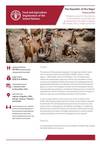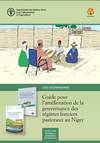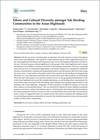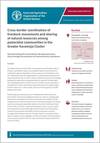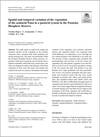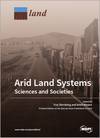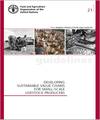The outcome of the pastoral campaign in the Niger was limited, mainly due to insecurity, which is disrupting the mobility of herds in certain regions − Diffa, Maradi, Tahoua and Tillabéry. This is threatening the livelihoods of pastoralists, especially of those most vulnerable. Limited access to and availability of fodder for livestock are putting pastoral and agropastoral livelihoods at risk. Mobility restrictions for both people and goods as a result of armed group activities, and the subsequent security measures taken by authorities, contribute to limiting access to markets for pastoralists to sell their livestock or animal products (milk and cheese) as well as to resources such fodder and water to for their livestock. In 2020, FAO plans to implement a series of activities aiming at assisting pastoral households who are vulnerable to the fodder deficit and insecurity.
Year of publication: 2020Organization: Organisation des Nations Unies pour l'alimentation et l'agriculture (FAO)
Topic: Conflit, Sécurité alimentaire, Résilience
Language: English, Français
Type of document: Technique
Geographical coverage: Afrique occidentale
Ce guide constitue un outil à destination des acteurs de terrain au Niger. Il vise à contribuer à l'amélioration de la gouvernance foncière pastorale et en particulier à la prévention et à la résolution des conflits et au développement de processus de concertation inclusifs.
Le guide est unique car il est élaboré en collaboration avec un pour les éleveurs au Niger. Il sera un outil concret pour aider les acteurs à résoudre les conflits liés à l'accès aux ressources naturelles au niveau local.
Year of publication: 2020Organization: Organisation des Nations Unies pour l'alimentation et l'agriculture (FAO)
Topic: Conflit, Les savoirs autochtones, Régime foncier, Participation
Language: Français
Type of document: Technique
Geographical coverage: Afrique occidentale
Yak herding plays an important role in the domestic economy throughout much of the Asian highlands from Russia and Kyrgyzstan in the west to the Hengduan Mountains of China in the east. Yak also has great cultural significance to the people of the Asian highlands and is closely interlinked to the traditions, cultures, and rituals of the herding communities. However, increasing issues like poverty, environmental degradation, and climate change have changed the traditional practices of pastoralism, isolating and fragmenting herders and the pastures they have been using for many years. Local cultures of people rooted in the practice of yak herding are disappearing. Therefore, it is very important to document the socioeconomic and cultural aspects of yak herding. The broad aim of this paper was to provide a brief overview on the geographical distribution of yak in the Asian highlands and to provide in-depth information on yak-herding ethnic communities, the sociocultural aspect associated with yak herding, and challenges and emerging opportunities for yak herding in the Asian highlands. Altogether, 31 ethnic groups in 10 different countries of Asia and their cultures are documented herein. Yak was found to be utilized for many different household purposes, and to have cultural and religious aspects. Unfortunately, yak rearing and related traditions have been losing their charm in recent years due to modernization and several other environmental issues. Lastly, we suggest that there is an urgent need to take action to minimize the challenges faced by yak-herding mountain communities to conserve the traditional pastoral system and associated cultures of these ethnic communities.
Year of publication: 2020Organization: Auteurs individuels
Topic: Peuples autochtones
Language: English
Type of document: Scientifique
Geographical coverage: Asie centrale
The Greater Karamoja Cluster (GKC) encompasses the southwestern parts of Ethiopia, northwestern Kenya, the southeastern parts of South Sudan and northeastern Uganda. Though livestock is a crucial livelihood asset, the region is poorly integrated into national livestock marketing systems and conspicuously absent from the vibrant business of livestock exports from the Horn of Africa.
Year of publication: 2019Organization: Organisation des Nations Unies pour l'alimentation et l'agriculture (FAO)
Topic: Participation, Résilience
Language: English
Type of document: Politiques et législation
Geographical coverage: Afrique orientale
This study aimed to analyze the spatial and temporal variation of the vegetation in the northern Argentine Puna, utilizing both field sampling and remote-sensing tools. The study was performed within the Pozuelos Biosphere Reserve (Jujuy Province, Argentina), which aims to generate socio-economic development compatible with biodiversity conservation.
Year of publication: 2019Organization: Auteurs individuels
Topic: Services environnementaux, Régime foncier
Language: English
Type of document: Scientifique
Geographical coverage: Amérique Latine
Through knowledge, documentation and evaluation, this book links academic disciplines to convey the complexities and possibilities existing across drylands. The chapters draw together a great variety of global drylands. Research explores the Gobi Desert and China, Central Asia and the Middle East, as well as multiple African dimensions and Latin America. The aim is to understand the essential themes that arid and semi-arid regions encounter and engage with today. This interdisciplinary study reflects the vital links between social and environmental science in global deserts. Using mixed methodologies and varied techniques, the original work stresses today’s topical themes to present novel analyses. The book offers much to dryland researchers, stakeholders and importantly, policy makers, who shape the world’s vast desert landscapes.
Year of publication: 2019Organization: Auteurs individuels
Topic: Régime foncier
Language: English
Type of document: Technique
Geographical coverage: Global
This publication constitutes a practical development tool, which implements the sustainable food value chain framework with a focus on small-scale livestock producers, targeting an audience of project design teams and policymakers. By integrating the concepts of value addition and the three dimensions of sustainability, the sustainable food value chain framework not only addresses questions concerning the competitiveness, inclusion and empowerment of small-scale producers, but also incorporates the cross-cutting issues that are increasingly embedded in development projects. These guidelines take the user through the different steps of value chain development, highlighting the particularities of the smallholder livestock sector, such as multi-functionality, specific production cycles or food safety issues, through concrete examples.
Year of publication: 2019Organization: Organisation des Nations Unies pour l'alimentation et l'agriculture (FAO)
Topic: Value addition
Language: English
Type of document: Technique
Geographical coverage: Global
The following paper is a report for Roads Less Travelled, a global partnership of DiversEarth, Yolda Initiative and Trashumancia y Naturaleza, which makes the case for mobile pastoralism (transhumance, nomadic and semi-nomadic pastoralism) at a global scale, through new research, support to pastoral communities, and through creative celebration of their knowledge and ways of life. This paper contributes to a stream of work by Roads Less Travelled on mobile pastoralists and protected areas.
Year of publication: 2019Organization: Auteurs individuels
Topic: Services environnementaux, Les savoirs autochtones
Language: English
Type of document: Technique
Geographical coverage: Global


